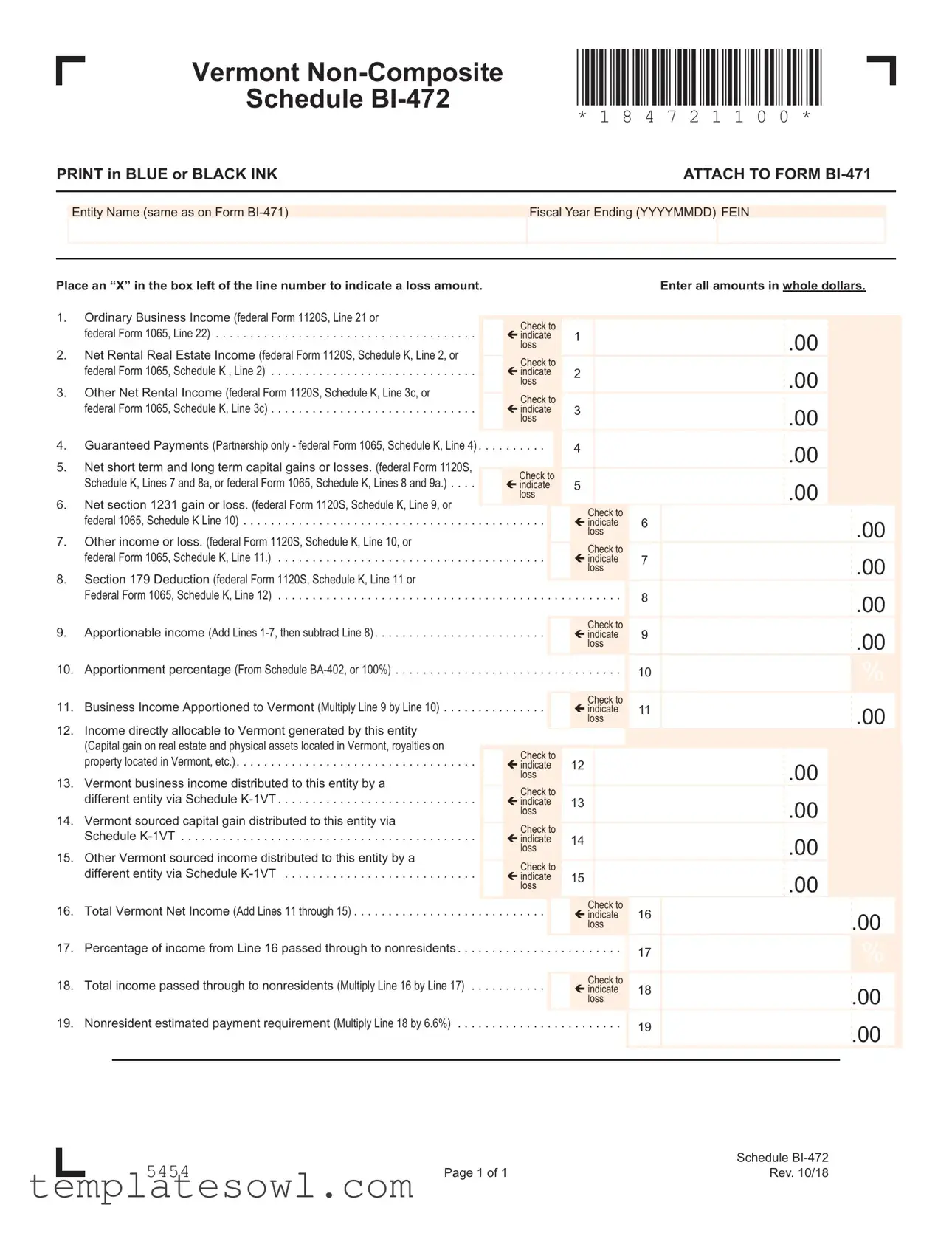|
|
|
|
|
Vermont Non-Composite |
|
|
|
*184721100* |
|
|
|
|
|
|
|
|
|
|
|
|
|
|
|
|
|
|
|
|
|
|
|
|
|
|
|
|
|
|
|
|
|
|
|
|
|
|
|
|
|
|
|
|
|
|
|
|
|
|
|
|
|
Schedule BI-472 |
|
|
|
* 1 8 4 7 2 1 1 0 0 * |
|
|
|
|
|
|
|
|
|
|
|
|
|
|
|
|
|
|
|
|
|
|
|
|
|
PRINT in BLUE or BLACK INK |
|
|
|
|
|
|
|
ATTACH TO FORM BI-471 |
|
|
|
|
|
|
|
|
|
|
|
|
|
|
|
|
|
|
|
|
|
|
|
|
|
|
|
|
|
|
|
|
|
|
|
|
|
|
|
|
|
|
|
|
|
|
|
Entity Name (same as on Form BI-471) |
|
Fiscal Year Ending (YYYYMMDD) |
FEIN |
|
|
|
|
|
|
|
|
|
|
|
|
|
|
|
|
|
|
|
|
|
|
|
|
|
|
|
|
|
|
|
|
|
|
|
|
|
|
|
|
|
|
|
|
|
|
|
Place an “X” in the box left of the line number to indicate a loss amount. |
|
|
|
|
|
|
|
Enter all amounts in whole dollars. |
|
1. |
|
Ordinary Business Income (federal Form 1120S, Line 21 or |
|
|
|
|
|
|
|
|
|
|
|
|
|
|
|
|
|
|
|
|
|
Check to |
|
|
|
|
|
|
|
|
|
|
|
|
|
|
|
|
federal Form 1065, Line 22) |
|
|
1 |
|
|
|
|
|
|
|
|
|
|
|
|
|
|
|
|
|
ç indicate |
|
|
.00 |
|
|
|
|
|
|
|
2. |
|
Net Rental Real Estate Income (federal Form 1120S, Schedule K, Line 2, or |
|
|
loss |
|
|
|
|
|
|
|
|
|
|
|
|
|
Check to |
2 |
|
|
|
|
|
|
|
|
|
|
|
|
|
|
|
|
|
|
|
|
|
|
|
|
|
|
|
|
|
|
federal Form 1065, Schedule K , Line 2) |
|
|
ç indicate |
|
|
.00 |
|
|
|
|
|
|
|
3. |
|
Other Net Rental Income (federal Form 1120S, Schedule K, Line 3c, or |
|
|
loss |
|
|
|
|
|
|
|
|
|
|
|
|
|
Check to |
3 |
|
|
|
|
|
|
|
|
|
|
|
|
|
|
|
|
|
|
|
|
|
|
|
|
|
|
|
|
|
|
federal Form 1065, Schedule K, Line 3c) |
|
|
ç indicate |
|
|
.00 |
|
|
|
|
|
|
|
|
|
|
|
|
|
|
|
loss |
|
|
|
|
|
|
|
|
|
|
4. |
|
Guaranteed Payments (Partnership only - federal Form 1065, Schedule K, Line 4) |
4 |
|
|
.00 |
|
|
|
|
|
|
|
5. |
|
Net short term and long term capital gains or losses. (federal Form 1120S, |
|
|
|
|
|
|
|
|
|
|
|
|
|
|
|
|
|
|
Check to |
|
|
|
|
|
|
|
|
|
|
|
|
|
|
|
|
Schedule K, Lines 7 and 8a, or federal Form 1065, Schedule K, Lines 8 and 9a.). . . |
|
|
5 |
|
|
|
|
|
|
|
|
|
|
|
|
|
|
|
|
|
ç indicate |
|
|
.00 |
|
|
|
|
|
|
|
6. |
|
Net section 1231 gain or loss. (federal Form 1120S, Schedule K, Line 9, or |
|
|
loss |
|
|
|
|
|
|
|
|
|
|
|
|
|
|
|
|
Check to |
|
|
|
|
|
|
|
|
|
|
|
|
|
federal 1065, Schedule K Line 10) |
|
6 |
|
|
|
|
|
|
|
|
|
|
|
|
|
ç indicate |
|
|
.00 |
|
|
7. |
|
Other income or loss. (federal Form 1120S, Schedule K, Line 10, or |
|
|
|
loss |
|
|
|
|
|
|
|
|
|
|
Check to |
7 |
|
|
|
|
|
|
|
|
|
|
|
|
federal Form 1065, Schedule K, Line 11.) |
|
ç indicate |
|
|
.00 |
|
|
8. |
|
Section 179 Deduction (federal Form 1120S, Schedule K, Line 11 or |
|
|
|
loss |
|
|
|
|
|
|
|
|
|
|
|
|
|
|
|
|
|
|
|
|
|
|
|
|
|
Federal Form 1065, Schedule K, Line 12) |
8 |
|
|
.00 |
|
|
|
|
|
|
|
|
|
|
|
|
|
|
|
|
|
|
|
|
|
9. |
|
Apportionable income (Add Lines 1-7, then subtract Line 8) |
|
Check to |
9 |
|
|
|
|
|
|
|
|
|
|
|
ç indicate |
|
|
.00 |
|
|
|
|
|
|
|
|
|
|
|
|
|
loss |
|
|
|
|
|
10. |
Apportionment percentage (From Schedule BA-402, or 100%) |
10 |
|
|
|
|
% |
|
|
|
|
|
|
|
|
|
|
|
|
|
|
|
|
|
|
|
|
|
|
|
|
|
11. |
Business Income Apportioned to Vermont (Multiply Line 9 by Line 10) |
|
Check to |
11 |
|
|
|
|
|
|
|
|
|
|
ç indicate |
|
|
.00 |
|
|
12. |
Income directly allocable to Vermont generated by this entity |
|
|
|
loss |
|
|
|
|
|
|
|
|
|
|
|
|
|
|
|
|
|
|
|
|
|
|
|
|
(Capital gain on real estate and physical assets located in Vermont, royalties on |
|
|
|
|
|
|
|
|
|
|
|
|
|
|
|
|
|
|
|
|
property located in Vermont, etc.) |
|
Check to |
12 |
|
|
|
|
|
|
|
|
|
|
|
|
|
|
|
|
ç indicate |
|
|
.00 |
|
|
|
|
|
|
|
13. |
Vermont business income distributed to this entity by a |
|
loss |
|
|
|
|
|
|
|
|
|
|
|
Check to |
|
|
|
|
|
|
|
|
|
|
|
|
|
|
|
|
|
|
|
|
|
|
|
|
|
|
|
|
|
|
different entity via Schedule K-1VT |
|
13 |
|
|
|
|
|
|
|
|
|
|
|
|
|
|
|
|
ç indicate |
|
|
.00 |
|
|
|
|
|
|
|
14. |
Vermont sourced capital gain distributed to this entity via |
|
loss |
|
|
|
|
|
|
|
|
|
|
|
Check to |
|
|
|
|
|
|
|
|
|
|
|
|
|
|
|
|
|
|
|
|
|
|
|
|
|
|
|
|
|
|
Schedule K-1VT |
|
14 |
|
|
|
|
|
|
|
|
|
|
|
|
|
|
|
|
ç indicate |
|
|
.00 |
|
|
|
|
|
|
|
15. |
Other Vermont sourced income distributed to this entity by a |
|
loss |
|
|
|
|
|
|
|
|
|
|
|
Check to |
|
|
|
|
|
|
|
|
|
|
|
|
|
|
|
|
|
|
|
|
|
|
|
|
|
|
|
|
|
|
different entity via Schedule K-1VT |
|
15 |
|
|
|
|
|
|
|
|
|
|
|
|
|
|
|
|
ç indicate |
|
|
.00 |
|
|
|
|
|
|
|
|
|
|
|
|
|
|
|
loss |
Check to |
|
|
|
|
|
|
|
|
|
|
|
|
|
|
|
|
|
|
|
|
|
|
|
|
|
|
|
|
16. |
Total Vermont Net Income (Add Lines 11 through 15) |
|
16 |
|
|
|
|
|
|
|
|
|
|
ç indicate |
|
|
.00 |
|
|
|
|
|
|
|
|
|
|
|
|
|
|
loss |
|
|
|
|
|
|
17. |
Percentage of income from Line 16 passed through to nonresidents |
|
17 |
|
|
|
|
% |
|
|
|
|
|
|
|
|
|
|
|
|
|
|
|
|
|
|
|
|
|
|
|
|
|
|
|
|
|
|
|
|
|
|
|
|
|
|
|
|
|
|
|
|
|
|
18. |
Total income passed through to nonresidents (Multiply Line 16 by Line 17) |
|
Check to |
|
|
|
|
|
|
|
|
|
|
|
ç indicate |
18 |
|
|
.00 |
|
|
|
|
|
|
|
|
|
|
|
|
|
|
loss |
|
|
|
|
|
|
19. |
Nonresident estimated payment requirement (Multiply Line 18 by 6.6%) |
|
19 |
|
|
.00 |
|
|
|
|
|
|
|
|
|
|
|
|
|
|
|
|
|
|
|
|
|
|
|
|
|
|
|
|
|
|
|
|
|
|
|
|
|
|
|
|
|
|
|
|
|
|
|
|
|
|
|
|
|
|
|
|
|
|
|
|
|
|
|
|
|
|

